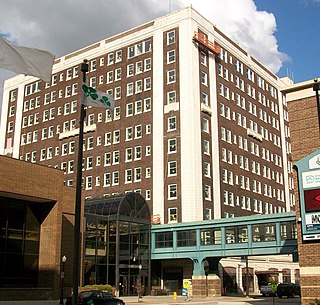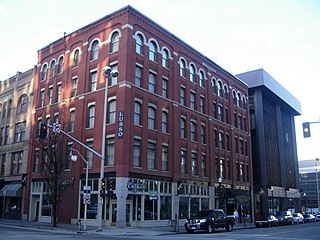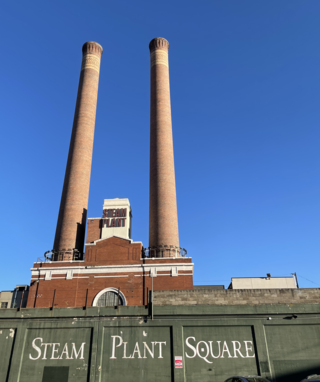
The Davenport Hotel is a hotel located in Spokane, Washington. Originally a successful high-end restaurant, it is one of the possible places where the first Crab Louis was created and served. The hotel was designed by architect Kirtland Cutter and built in 1914 for $2 million with an opulent lobby and new amenities for the time such as air conditioning, a central vacuum system, pipe organ, and dividing doors in the ballrooms. Commissioned by a group of Spokane businessmen to have a place to host and entertain their guests, the hotel is named after Louis Davenport, an influential businessman and the first proprietor and overseer of the project.

The Knickerbocker on the Lake is a historic hotel opened in 1929, located in the Yankee Hill neighborhood of downtown Milwaukee, Wisconsin. It was built as an eight-story residential apartment hotel. In 1988 it was listed on the National Register of Historic Places.

The Candler Building is a 17-story high-rise at 127 Peachtree Street, NE, in Atlanta, Georgia. When completed in 1906 by Coca-Cola magnate Asa Griggs Candler, it was the tallest building in the city. This location where Houston joins Peachtree Street was the location of one of the earliest churches in the city which was built on land donated by Judge Reuben Cone in the 1840s. It forms the northern border of Woodruff Park.

The Keating Building, also known as The Keating Hotel, is a 35-room luxury boutique hotel in San Diego. Located in the center of the Gaslamp Quarter, the Keating is located near the San Diego Convention Center, Balboa Theater, and Petco Park.

The Hotel Blackhawk is an eleven-story brick and terra cotta building located in Downtown Davenport, Iowa, United States. It is a Marriott Autograph Collection property.

The German American Heritage Center, also known as the Germania-Miller/Standard Hotel, is a cultural center and museum in Davenport, Iowa, United States, that chronicles and preserves the history of German-Americans in the Midwest region. The building was listed on the National Register of Historic Places in 1983.

The J.H.C. Petersen's Sons' Store also known as the Petersen Harned-Von Maur Store Building and the Redstone Building, is a historic building in Davenport, Iowa, United States. It was individually listed on the Davenport Register of Historic Properties and on the National Register of Historic Places. In 2020 it was included as a contributing property in the Davenport Downtown Commercial Historic District. The former department store building was modeled on the Rookery Building in Chicago.

The Mississippi Lofts and Adler Theatre is an apartment building and theater complex located in downtown Davenport, Iowa, United States. It is individually listed on the National Register of Historic Places by its original name, the Hotel Mississippi and RKO Orpheum Theater. The Hotel Mississippi was listed on the Davenport Register of Historic Properties in 2005. In 2020 the complex was included as a contributing property in the Davenport Downtown Commercial Historic District.

The Davenport Hotel was a historic building located in downtown Davenport, Iowa, United States. It was individually listed on the National Register of Historic Places in 1983. In 2020 it was included as a contributing property in the Davenport Downtown Commercial Historic District. It was an apartment building called The Davenport. A rear portion of the building collapsed in 2023. The majority of the building was demolished on June 12, 2023. Several remaining sections were demolished over the next three days.

The Burtis–Kimball House Hotel and the Burtis Opera House were located in downtown Davenport, Iowa, United States. The hotel was listed on the National Register of Historic Places in 1979. It has since been torn down and it was delisted from the National Register in 2008. The theatre building has been significantly altered since a fire in the 1920s. Both, however, remain important to the history of the city of Davenport.

The Bauer Manor, also known as the Davenport House or Davenport Hotel, is a hotel located at 1280 U.S. Route 12 near the unincorporated community of Tipton in Franklin Township in northern Lenawee County, Michigan. It was designated as a Michigan State Historic State on May 18, 1971 and listed on the National Register of Historic Places on May 4, 2007.

The Putnam-Parker Block, also known as City Square, are historic structures located in downtown Davenport, Iowa, United States. The property includes three buildings that take up the south half of block 43 in what is known as LeClaire's First Addition. The main façade of the structures face south along West Second Street. They were listed on the National Register of Historic Places in 2011. In 2020, it was included as a contributing property in the Davenport Downtown Commercial Historic District. The former Putnam Building now houses a Marriott Autograph Collection hotel named The Current Iowa.

The Ridpath Hotel is a complex of four buildings in Spokane, Washington – the Ridpath Tower, the Halliday Building, the Y Building, and the Executive Court building. The Ridpath Tower, the main portion of the hotel, was designed by San Francisco architect Ned Hyman Abrams and is the second iteration of the Ridpath Hotel – the original building was destroyed by fire in 1950. The hotel, originally opened in 1900 and closed in 2008, and has now been fully renovated and opened as a low-income apartment complex called Ridpath Club Apartments in 2017. It has the distinction of being Spokane's longest continuously run hotel through those 108 years. The Ridpath reopened as the Ridpath Club Apartments in March 2018. The building offers the first micro apartments available in the city, which are essentially a converted hotel room designed to be affordable housing units or workforce housing.

The Utopia Hotel is a historic building in Nashville, Tennessee.

The Davenport Hotel Collection is a brand collection of four upscale hotels in Spokane, Washington. All the hotels are located in Downtown Spokane. The brand is owned by KSL Capital Partners and operated by the Davidson Hospitality Group.

The Whitten Block is a historic five-story building in Spokane, Washington. It was designed by architect Lorenzo M. Boardman, and built in 1890 for investor Leydford B. Whitten at a cost of $40,000. Tenants included a dry goods store, a flower shop, a shoe repair store, a candy store as well as clothing stores.

The Downtowner Motor Inn is a historic motel on Central Avenue in Downtown Albuquerque, New Mexico. Opened in 1965, it was originally part of the Downtowner chain, which operated economy-priced motels in city centers across the U.S. In 1972, the motel was sold and became a Quality Inn. It has also operated as a Ramada and most recently as the Hotel Blue, which closed in 2017. In 2020, it was announced that the motel would be renovated by the Los Angeles-based ARRIVE Hotels & Restaurants to reopen in 2022. These plans were delayed by the COVID-19 pandemic, and ARRIVE Hotels was purchased by a different hotel company, Palisociety, in 2021. Renovation work began in early 2022.

Spokane and its neighborhoods contain a patchwork of architectural styles that give them a distinct identity and illustrate the changes throughout the city's history. Spokane has a rich architectural history for a western city of its size and much of it is a product of its circumstances at the turn of the 20th century when as a rapidly growing city, the Great Fire of 1889 destroyed 32 blocks of the city center which was quickly rebuilt in a more grand fashion by a community flush with money coming from regional mining districts. Many of the architects that found work in the city and building on the blank slate of the downtown commercial district became highly esteemed architects such as Kirtland Cutter, who has been credited with giving the city a distinctive character. In particular, the city has a high concentration of Romanesque Revival style institutional and commercial buildings and American Craftsman bungalow residences. The architecture of Spokane gained national recognition in industry publications in the early 20th century.

The Central Steam Heat Plant, commonly known as Steam Plant Square, or simply as the Steam Plant, is a historic building in Downtown, Spokane, Washington. Originally built to provide steam heating to more than 300 buildings in Spokane's city center, the Steam Plant served that purpose until the 1980s, when it was no longer viable. In the 1990s, the Steam Plant and adjacent Seehorn-Lang Building were converted into Steam Plant Square, a commercial, retail and restaurant center. The conversion maintained many of the industrial steam plant structures such as furnaces, boilers, catwalks and pipe networks, which can still be seen and explored by visitors and patrons. The Steam Plant's pair of 225 foot tall stacks have been a unique and iconic aspect of the city's skyline for more than a century, and are illuminated from their base at night. If the stacks were considered to be a building, they would rank as the third tallest in the city.

The West Downtown Historic Transportation Corridor is a historic commercial district in Spokane, Washington located, as the name suggests, in the western portion of the city's downtown neighborhood. The district, which was listed on the National Register of Historic Places (NRHP) in 1999, consists mostly of buildings constructed between the late 19th century and 1949. It contained at the time of listing 65 buildings or structures, 50 of which are considered contributing properties to the district. Seven properties in the district are listed on the NRHP individually as well.





















